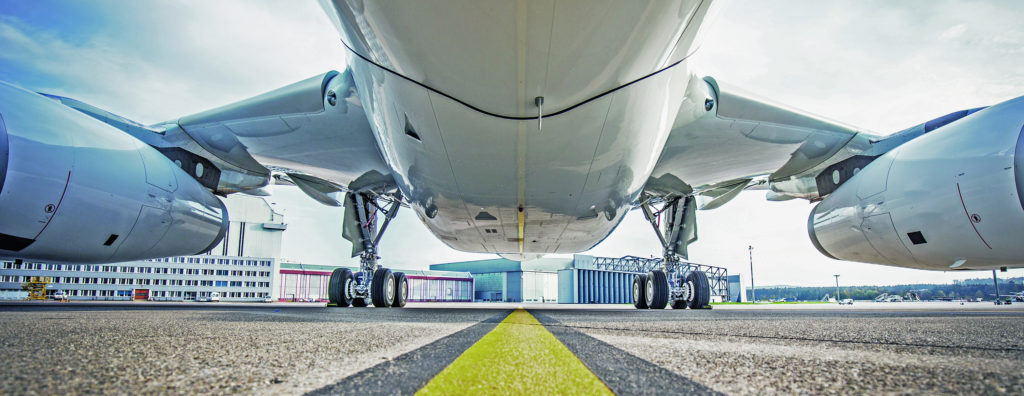Sector breakdown

Engines
The aero engine value chain comprises of material suppliers, engine components suppliers and engine sub-system providers, all of whom specialise in different modules and technologies.
Given that the market is highly demanding regarding technology expertise, and that the development of new engines and engine parts requires substantial upfront investments, the engine industry is characterised by limited competition with high barriers to entry. Suppliers along the aero engine value chain also have to commit to long-term contracts with OEMs.
Industry 4.0 provides huge potential for production process optimisation, while intelligent machine control and optimisation of material flow are transforming the production of aero engine components and systems. The increasing use of composite materials in aircraft is also driving the rising use of sensors in planes, as damage to composite materials is harder to spot.
Most analysts believe that smaller passenger aircraft driven by propellers will be among the first to convert to electric propulsion.
Additive manufacturing
Additive manufacturing brings potentially huge benefits for the industry in terms of the production of lightweight parts with complex geometries and stationary turbine components. It also has the potential to shorten the development process and time to market, as well as giving suppliers the freedom to design complex geometries which maximise performance, consolidate design, and improve reliability – thereby helping to achieve lighter weight aircraft and improved fuel efficiency.
Electric future
As seen in the automotive market, there is now great debate about the potential of electrification to transform the industry, and the extent to which hybrid solutions could be increasingly employed in the short to medium-term as battery technologies are developed.
Most analysts believe that smaller passenger aircraft driven by propellers will be among the first to convert to electric propulsion. For instance earlier this year Harbour Air, North America’s largest seaplane airline, announced a partnership with magniX to transform its seaplanes into an all-electric commercial fleet.
Israeli start-up Eviation is also developing a nine-seater electric aircraft called Alice, which is designed to fly up to 650 miles, while Airbus is working with Rolls-Royce and Siemens to electrify a 100-seater regional aircraft called the BAe146.
The rush to go electric is also driving M&A activity. Rolls-Royce recently agreed to acquire Siemens’ electric and hybrid-electric aerospace propulsion business in order to accelerate its electrification strategy.
Aerostructures
With fuel accounting for almost a quarter of airlines’ operating expenses, manufacturers are experimenting with a vast range of new products in order to make aircraft ever stronger and more efficient.
For example, the airframe of the Airbus A350 is now 53% composite, making it 25% more fuel efficient, while Boeing’s Dreamliner is 50% composite and around 20% more efficient.
Both companies are at the forefront of innovation and unearthing new methods of production. For instance Airbus is working with German biotech company AMSilk on using artificial spider silk to create a new generation of composite material that could revolutionise aerospace design. AMSilk is the world’s first industrial supplier of synthetic silk biopolymers.
Airbus is also working on its Breakthrough Laminar Aircraft Demonstrator in Europe (BLADE) project which is exploring the use of Natural Laminar Flow (NLF) technologies for smart wings which do not have any joints or rivets. NLF wings can potentially help reduce drag and therefore cut fuel consumption.
Boeing is working on the Transonic Truss-Braced Wing which, likewise, is designed to be more aerodynamic and fuel efficient. The higher wingspan is made possible by a truss which supports the extended length of the ultra-thin wing.
Electronics
The ongoing investigation into the Boeing 737 Max aircraft shows how electronic systems, and particularly the use of more automated systems in aircraft, will become ever more important, especially as debate continues over how deeply automation and artificial intelligence should take hold across the industry.
Two years ago Airbus launched Skywise, an open data platform of reference used by major aviation players to improve operational performance, ensuring complete data continuity with benefits across the entire value chain.
More than 80 airlines have now connected their Airbus and non-Airbus fleet to Skywise, which provides all users with one single access point to their aggregated and anonymised aviation data gained from multiple sources across the industry into one secure, cloud-based platform.
The platform allows automated reporting, benchmarking capacity, and access to applications, thereby improving airlines’ operations and reducing their costs. The more data that airlines or OEMs share via the Skywise Core platform, the more accurate the predictions and models are for connected customers.
Airbus says that by making the right information available at the right time, Skywise provides invaluable insights from the massive amounts of data that was previously locked in corporate and functional silos.
MRO market
The Maintenance, Repair and Overhaul (MRO) market is growing fast with total MRO spending forecast (1) to rise to $114.7bn (€102bn) by 2028 at a CAGR of 4%. Growth will average 3.5% from 2018 to 2023, and then 4.5% between 2023 and 2028.
The report says some of the fastest growth is projected for MRO operations owned by aircraft manufacturers and other major original equipment manufacturers. Boeing, for instance, has set a €44.6bn goal for its aftermarket services as part of its effort to capture more life-cycle value out of its aircraft. OEMs servicing engines handle more than half of the market, while airlines and their affiliated MRO operations control almost two thirds of the airframe maintenance market.
An exciting driver of the MRO market is the increasing amount of sensors and technology that is installed within today’s engines, which brings huge potential to use generated data within the aftermarket as recorded data which can be used to optimise fuel consumption, engine lifetime, and reduce maintenance costs.


